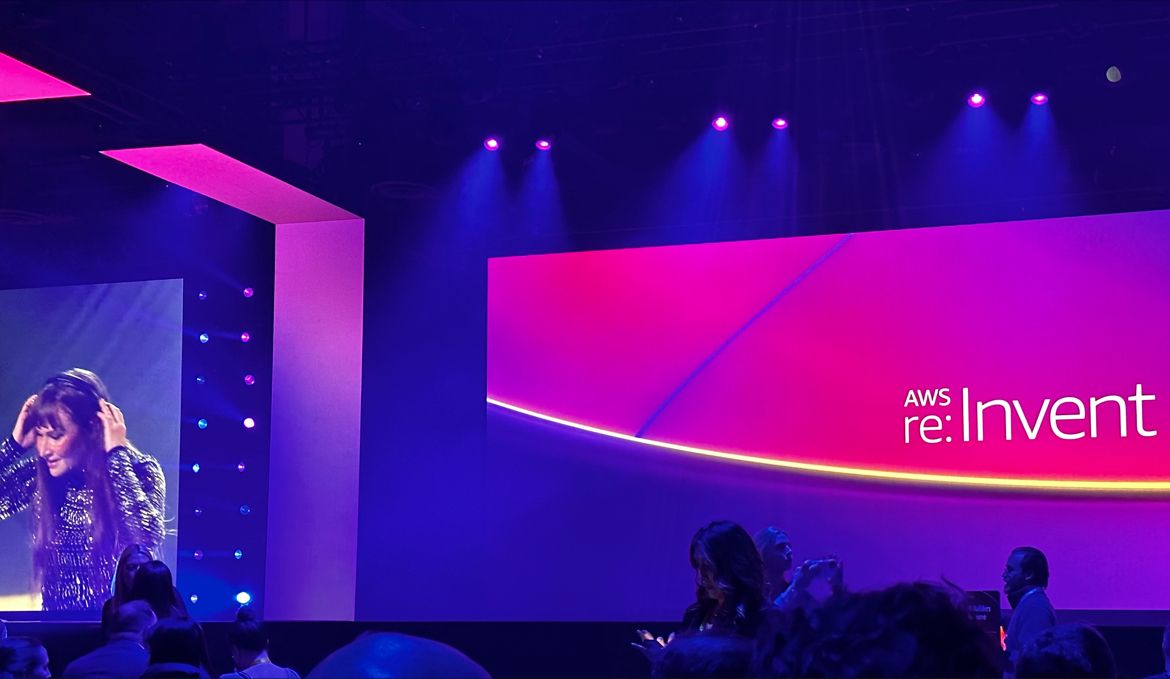Technology
Dec 02, 2022
AWS re:Invent 2022: Top takeaways from Adam Selipsky’s keynote speech

“What happens in Vegas... doesn’t stay in Vegas!”
Credera attended the 11th annual AWS re:Invent conference in Las Vegas this year – an event that was attended by 50,000 people in person, splitting their time among 2,300+ sessions.
This year was a particularly exciting one for our cloud technology teams. Not only was it the first time that our UK team attended re:Invent in person after the pandemic, but it was also the first time both UK and U.S. colleagues attended the event together as one global team.
Highlights from Adam Selipsky’s Keynote Speech
Coming into this year's session, we expected an ever-increasing focus on cost optimisation, energy saving, and machine learning services. Selipsky began the keynote with a commitment to become water positive by 2030 – a promise that proved to be a real crowd pleaser.
During these times of economic uncertainty, customers were leaning into the cloud, thus enabling reduction in costs and flexibility of pay as you use. However, unlike previous years, we were not treated to the same volume and enormity of announcements during this keynote.
Within his keynote speech, Selipsky addressed the following key developments within the Cloud space:
1. Data Exploration
This is a data catalogue-type feature which brings data and people together. It can be used to catalogue, discover, share, and govern access to data at scale across organisational boundaries, with governance and access controls. It integrates with other AWS services such as Amazon Redshift, Amazon Athena, and Amazon QuickSight, and offers AWS customers a potential alternative to COTS solutions such as Informatica. Azure and GCP already have their own services in this space, meaning AWS will be brought to parity. This could be of particular interest to clients who wish to consolidate their monthly bill.
Comparing the vastness of data to Space, Selipsky mentioned that AWS provides the right tools to tackle the data explosion, including Amazon Aurora and AWS Analytics Services, Amazon Athena, Amazon EMR, and Amazon Kinesis.
Fully managed Amazon Aurora integration with Amazon Redshift
Selipsky promised a “zero ETL future” with the introduction of a fully managed Amazon Aurora integration with Amazon Redshift. With this innovation, transactional data is made available on Amazon Redshift seconds after being written on Amazon Aurora. This removes the necessity of building and maintaining complex data pipelines to extract, transform, and load operations. This could be considered an antipattern, as we generally avoid coupling operational and analytical systems.
ML-powered forecasting with Q and ask ‘why’ questions with Q
Innovations continue on the one-year-old Amazon QuickSight Q, which is a natural language capability that lets users ask simple questions of their data. Now, users can forecast a metric to the future or even ask a ‘why’ question with Amazon QuickSight Q. We believe this feature would only work if the data is modelled to a high standard, which takes time and effort to refactor.
2. Security
Comparing “modern IT” to an ocean, Selipsky mentioned that security of apps would only be made possible through secure global infrastructure, where speed isn’t compromised for security. This would also include the availability of security tools and integration with other security solutions.
He also announced “container runtime threat detection for Amazon GuardDuty” and Amazon Security Lake. The former goes beyond just checking containers before they are deployed and extends to monitoring their interactions with the OS while they are running. This will help provide some comfort in a world where container exploits are still common. The latter can automatically collect and analyse security data and support Open Cybersecurity Schema Framework (OCSF).
While we believe that Amazon Security Lake is a step in the right direction, effective security isn’t just about piling up lots of well-structured data; it also requires an operational and people transformation.
3. Compute Integrations
With the illustration of the “race to reach the South Pole,” Selipsky quoted:
“When you face extreme environments, good enough simply isn’t good enough.”
AWS continues innovations in the processors and EC2 instances with the introduction of Graviton 3, Inf 2 and Hpc7g, Hpc6id instances for high performance computing.
Other announcements from Selipsky
Within his talk, Selipsky also shared several other noteworthy announcements:
Amazon OpenSearch Serverless: While most of the AWS Analytics services have serverless offerings, Amazon OpenSearch Serverless service was launched. With this, customers can search and analyse workloads without managing clusters.
Amazon Redshift integration for Apache Spark: Where previously developers had to use unreliable third-party Apache Spark connectors to connect to Amazon Redshift, general availability of Amazon Redshift integration for Apache Spark enables seamless integration of the two services.
Reimagining Contact Centres: With the increasing use of Amazon Connect during and after the pandemic, it has three new capabilities this year - Amazon Connect machine learning-driven forecasting, capacity and scheduling, Contact Lens for Amazon Connect with agent performance management, and Amazon Connect Agent workspace, with guided step-by-step actions.
AWS Simspace Weaver: This is a compute service that runs massive simulations without the need to manage infrastructure.
Amazon Supply Chain: This is a machine learning-driven cloud application which provides a unified view of supply chain data to help customers improve visibility and deliver actionable insights.
AWS Clean Rooms: The introduction of AWS Clean Rooms helps users to easily analyze and collaborate on datasets without sharing or revealing underlying datasets.[MR(6] It is particularly useful to optimize marketing and advertising experiences by providing enhanced customer insights. It also helps users to form better predictions of market trends and risk assessments by analyzing highly sensitive disparate datasets.
Amazon Omics: This helps store, query, analyze, and generate insights for omics data. It integrates with other offerings likeSageMaker and HealthLink, and can transform biological data into patient insights.
Just Walk Out: In the retail market, AWS claims that the “Just Walk Out” technology - which involves simply waving your palm over a scanner rather than using your phone, which would revolutionise retail!
In a nutshell
There were a few noteworthy announcements in Adam Selipsky’s keynote, some of which do have the potential to fill several gaps in the AWS service ecosystem.
We at Credera are looking forward to using these AWS innovations in data, security, and infrastructure to help our customers create a better future with greater speed and agility.
As an Advanced Consulting Partner, Credera offers our clients end-to-end AWS solutions that increase flexibility, scalability, and security while helping them innovate and improve performance. We have expertise in delivering AWS projects for DevOps, machine learning, security, migration, and big data. Leveraging our capabilities in marketing and commerce, digital media, and financial services, we help organisations solve immediate and long-term challenges by leveraging native services from AWS.
Contact Us
Ready to achieve your vision? We're here to help.
We'd love to start a conversation. Fill out the form and we'll connect you with the right person.
Searching for a new career?
View job openings